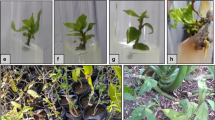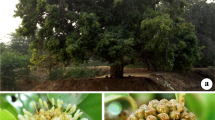Summary
Leptadenia reticulata (Retz.) Wight. & Arn., an important herbal medicinal plant, belongs to the family Asclepiadaceae. This plant has been known for its medicinal uses since 4500 BC. Presently this is an endangered species. There is a need for applying non-conventional methods of propagation for conservation and sustainable utilization of biodiversity of Leptadenia reticulata. We developed a micropropagation method for mass multiplication of L. reticulata. Explants harvested from greenhouse-maintained and field-grown plants were used to establish cultures of L. reticulata. The nodal shoot segments were surface-sterilized and cultured on Murashige and Skoog (MS) medium along with additives (25 mg l−1 each of adenine sulfate, arginine, and citric acid, and 50 mg l−1 ascorbic acid) containing 0.6 μM indole-3-acetic acid (IAA) and 9 μM N6-benzyladenine (BA). Three to four shoots differentiated from each node within 25–30 d at 26±2°C and 36 μmol m−2 s−1 spectral flux photon (SFP) for 12 hd−1. Shoots were further multiplied by (1) repeated transfer of mother explant on fresh medium containing 0.6 μM IAA and 2.2 μM BA, and (2) subculture of in vitro-differentiated shoots on MS medium with 6.6 μM BA and 0.6 μM IAA. After three or four subcultures, the basal clump with shoot bases was divided into three or four subclumps and multiplied on the fresh medium. From each clump 15–20 shoots regenerated within 25 d. Ninety percent of the in vitro-produced shoots rooted ex vitro if these were pulse-treated with 123 μM each of indole-3-butyric acid and β-naphthoxyacefic acid. The plantlets were transferred to bottles containing sterile ‘soilrite’ (soilless compost and soil conditioner) moistened with half-strength MS macrosalts. Ninety-five percent of the plantlets were hardened in the bottles within 15 d. The hardened plants were then transferred to black polybags in the nursery. Field transferred plants are growing normally and have flowered. The protocol developed is reproducible. From a single nodal segment about 1700 hardened plants could be regenerated within 174 d.
Similar content being viewed by others

References
Anjaria, J. V. Ethano veterinary medicine in South Asian countries: past, present and future. Pune. India: BAIF; 1997.
Anonymous, The wealth of India, raw materials, vol. 6: L-M. New Delhi: Council of Scientific and Industrial Rescarch (CSIR); 1962:73.
Arya, V.; Singh, R. P.; Shekhawat, N. S. A micropropagation protocol for mass multiplication and off-site conservation of Celastrus paniculatus—a vulnerable medicinal plant of India. J. Sustainable Forest. 14:107–120; 2002.
Bonga, J. M.; Von Aderkas, P. In vitro cultures of trees, vol. 38. Dordrecht: Kluwer Academic Publishers; 1992.
Deora, N. S.; Shekhawat, N. S. Micropropagation of Capparis decidua (Forsk). Edgew.—a tree of arid horticulture. Plant Cell Rep. 15:278–281; 1995.
Edson, J. L.; Wenny, D. L.; Leege-Brusven, A. D.; Everett, R. L. Using micropropagation to conserve threatened rare species in sustainable forests. J. Sustainable Forest. 5:279–291; 1997.
Gomez, K. A.; Gomez, A. A. Statistical procedure for agricultural research. New York: John Wiley & Sons; 1984.
Hall, R. D. Plant cell culture initiation: practical tips. Mol. Biotechnol. 16:161–173; 2000.
Kaur, G.; Rathore, T. S.; Rama Rao, S.; Shekhawat, N. S. In vitro micropropagation of Caralluma edulis (Edgew.) Benth. & Hook f. —a rare edible plant species of Indian Desert. Indian J. Plant. Genet. Resources 5:51–56; 1992.
Komalavalli, N.; Rao, M. V. In vitro micropropagation of Gymnema sylvestre —a multipurpose medicinal plant. Plant Cell Tiss. Organ Cult. 61:97–105; 2000.
McClelland, M. T.; Smith, M. A. L.; Carothers, Z. B. The effect of in vitro and ex vitro root initiation on subsequent microcutting root quality in three woody plants. Plant Cell Tiss. Organ Cult. 23:115–123; 1990.
Murashige, T.; Skoog, F. A revised medium for rapid growth and bioassays with tobacco tissue cultures. Physiol. Plant. 15:473–497; 1962.
Shekhawat, N. S.; Mughal, M. H.; Johri, B. M.; Srivastava, P. S. Indian contribution of plant tissue and organ culture. In: Srivastava, P. S., ed. Plant tissue culture and molecular biology: application and prospects. New Delhi: Narosa Publishing House; 1998:751–811.
Shekhawat, N. S.; Rathore, T. S.; singh, R. P.; Deora, N. S.; Rao, S. R. Factors affecting in vitro clonal propagation of Prosopis cineraria. Plant. Growth Regul. 12:273–280; 1993.
Shekhawat, N. S.; Yadav, J.; Arya, V.; Singh, R. P. Micropropagation of Anogeissus latifolia (Roxb. Ex DC.) Wall. Ex. guill. and Perr.—a tree of fragile ecosystems. J. Sustainable Forest. 11:83–96; 2000.
shetty, B. V.; Singh, V. Flora of India, series 2: flora of Rajasthan. Calcutta: Botanical Survey of India; 1991.
Singh, R. P.; Shekhawat, N. S. Micropropagation of Anogeissus rotundifolia Blatt. and Hallb.—an endemic and rare tree of the Thar Desert. J. Sustainable Forest. 4:159–170; 1997.
Singh, V.; Pandey, R. P. Ethnobotany of Rajasthan, India. Jodhpur: Scientific Publishers (India); 1998.
Snedecor, W. G.; Cochrn, G. W. Statistical methods. New Delhi: Oxford and IBH Publishing Co.; 1967.
Sudha, C. G.; Krishnan, S. S.; Pushpangadan, P. Regeneration of plants from in vitro root segments of Holostemma annulare (Roxb.) K. Schum., a rare medicinal plant. Curr. Sci. 78:503–506; 2000.
Author information
Authors and Affiliations
Corresponding author
Rights and permissions
About this article
Cite this article
Arya, V., Shekhawat, N.S. & Singh, R.P. Micropropagation of Leptadenia reticulata—A medicinal plant. In Vitro Cell.Dev.Biol.-Plant 39, 180–185 (2003). https://doi.org/10.1079/IVP2002394
Received:
Accepted:
Issue Date:
DOI: https://doi.org/10.1079/IVP2002394



